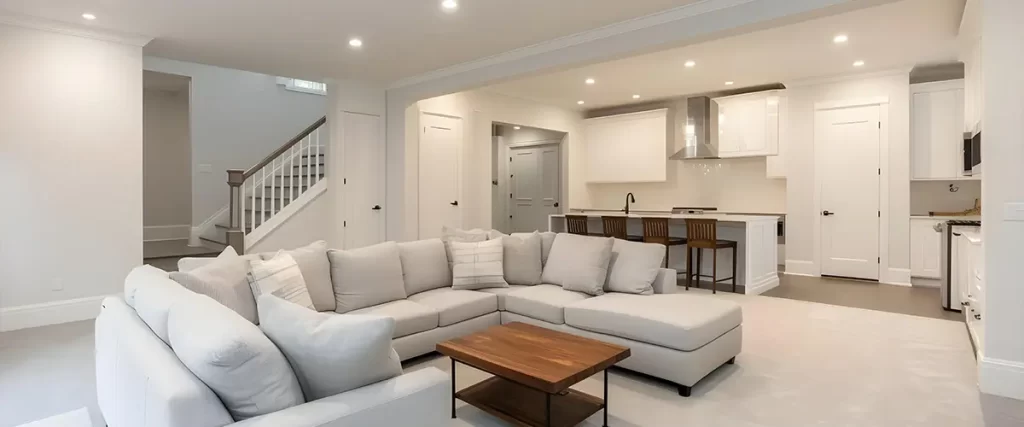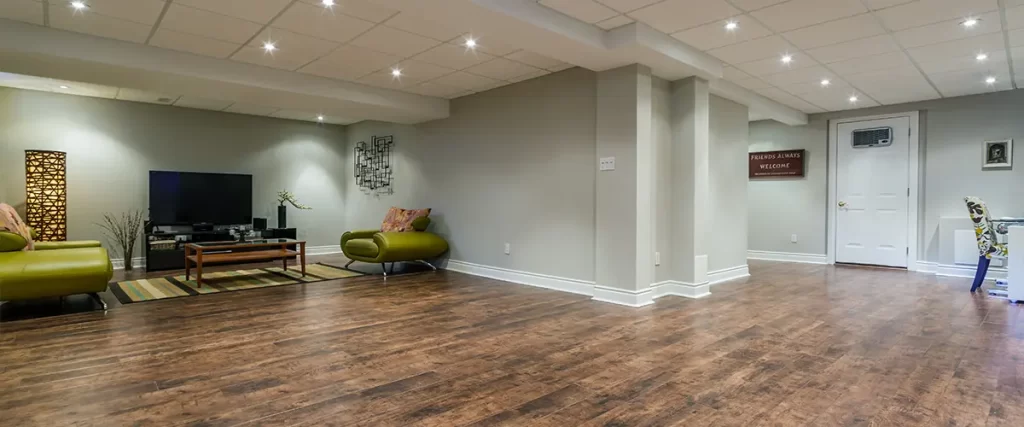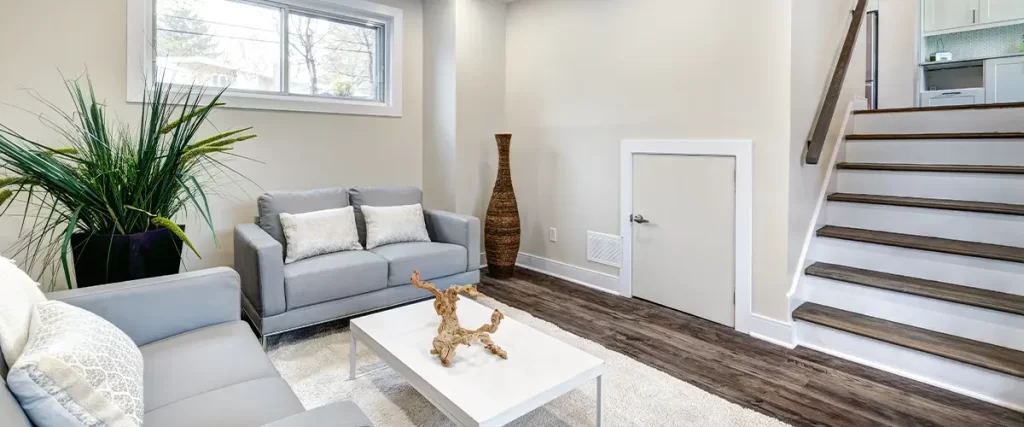Remodeling a basement is an exciting project that can add valuable living space to your home. However, basements are notorious for mold issues if moisture isn’t properly managed—especially in Bear, DE.
Mold growth not only causes unpleasant odors and mildew problems, but it can also lead to health risks and even structural damage to your home’s foundation over time. The good news is that with the right strategies, you can prevent mold before, during, and after your basement remodel.
In this guide, we’ll explain how hard water, water leaks, and poor ventilation contribute to mold in basements and share practical steps to keep your remodel mold-free. We’ll discuss methods to fix moisture problems, the importance of waterproofing, the best materials to use, and how to maintain proper airflow in your basement.
Plus, we’ll cover natural and chemical solutions for quickly removing any mold that does appear. By the end of this post, you’ll have a clear roadmap for ensuring your remodeled basement stays dry, healthy, and free of mold.

Causes of Basement Mold
Moisture from Leaks and Seepage
Basements are especially vulnerable to water leaks. Even a small leak from a water heater, plumbing, or a crack in the foundation can lead to damp conditions. Water seepage from the exterior is common in older homes, where water can infiltrate through poorly sealed walls or foundation cracks. Over time, this moisture accumulates, creating the ideal environment for mold to grow.
Condensation and High Humidity
Hard water and high humidity levels play a significant role in basement mold issues. When warm, moist air comes into contact with cold surfaces like concrete floors or foundation walls, condensation occurs. This moisture can accumulate on surfaces, leading to mold growth if not addressed. In Bear, DE, fluctuating indoor temperatures can exacerbate this problem, particularly if the basement lacks proper insulation and ventilation.
Poor Ventilation
A basement with poor ventilation will trap moisture, making it even easier for mold to develop. Stagnant air allows moisture to settle on surfaces, and without adequate air circulation, humidity levels remain high. Areas that lack windows or proper ductwork can become hotbeds for mold, even if no visible water damage is present.
How Moisture and Humidity Contribute to Mold
Mold spores are present everywhere, but they only thrive when conditions are right. In a basement remodel, excess moisture is the number one factor that encourages mold growth. When water is present—whether through direct leaks, condensation, or humid air—it provides the moisture that mold needs to grow and spread. Over time, even minor moisture issues can lead to extensive mold colonies if not properly managed.
- Moisture Buildup: Water can seep into porous materials such as drywall and wood, creating a food source for mold.
- High Humidity: Indoor relative humidity above 60% is a strong risk factor for mold.
- Condensation: Cold basement surfaces cause moisture in the air to condense, leading to damp spots that encourage mold growth.
Controlling these factors is crucial for preventing mold during and after your basement remodel.
Preventing Mold Before and During Your Remodel
Step 1: Inspect and Address Existing Moisture Problems
Before starting any remodel work in Bear, DE, thoroughly inspect your basement for signs of moisture and mold. Look for:
- Water stains or discoloration on walls and ceilings.
- Musty odors indicating mold presence.
- Cracks in foundation walls or floors.
- Areas where water pools or leaks occur.
Once identified, address these issues by repairing leaks, sealing foundation cracks, and ensuring proper drainage around your home. If you find significant mold, it’s important to remove it completely before proceeding with the remodel.
Step 2: Dry Out the Basement Completely
If your basement has been exposed to moisture, dry it out fully using fans and dehumidifiers. It’s essential to remove all moisture to prevent mold from forming when you begin construction. Run dehumidifiers until the air is dry, and check that walls, floors, and insulation are completely free of moisture.
Step 3: Waterproof the Basement
Waterproofing is a critical step to prevent water from entering your basement during future storms. Consider both interior and exterior waterproofing measures:
- Seal Exterior Walls: Use waterproof coatings on foundation walls to block water seepage.
- Improve Drainage: Ensure the ground around your home slopes away from the foundation and that gutters and downspouts are functioning properly.
- Install Interior Drainage Systems: An interior French drain system can help manage any water that does make its way in, directing it to a sump pump.
- Use a Sump Pump: A properly installed sump pump will remove any collected water, preventing standing water and reducing the risk of mold.
Step 4: Choose Mold-Resistant Materials
When remodeling, select materials that are less likely to support mold growth:
- Mold-Resistant Drywall: Use green board or mold-resistant drywall for walls.
- Pressure-Treated Wood: For any wood that comes in contact with concrete or damp areas, use pressure-treated lumber.
- Non-Porous Flooring Options: Consider using vinyl planks, ceramic tiles, or sealed concrete floors rather than carpets, which can harbor mold.
Step 5: Enhance Ventilation and Airflow
Proper ventilation is key to controlling humidity and preventing mold. Make sure your basement has adequate airflow:
- Install Exhaust Fans: Use fans in any bathrooms or laundry areas to remove moist air.
- Improve HVAC Circulation: Ensure your heating and cooling systems distribute air evenly. If your basement is connected to central HVAC, add vents or fans to boost circulation.
- Open Windows When Possible: If weather permits, open windows to allow fresh air to circulate.
Step 6: Use Protective Sealants and Finishes
After your remodel, apply high-quality sealants and mold-resistant finishes to all surfaces. These treatments provide an extra barrier against moisture:
- Sealants on Walls and Floors: Use waterproof sealants on concrete floors and basement walls.
- Mold-Resistant Paint: Choose paints that include antimicrobial additives to help prevent mold growth on surfaces.
- Caulking and Weatherstripping: Seal all gaps around windows, doors, and where the wall meets the floor to prevent moisture from entering.

Long-Term Maintenance for a Mold-Free Basement
After your basement remodel is complete, ongoing maintenance is essential to keep mold at bay. Here are some long-term strategies:
- Regular Cleaning: Clean surfaces regularly using mold-killing solutions like a mild bleach solution or natural alternatives like vinegar and water.
- Monitor Humidity Levels: Keep a hygrometer in your basement to track relative humidity. Aim for a range of 30-50% to prevent mold growth.
- Inspect for Leaks: Periodically check for signs of water intrusion, such as damp spots or condensation, and address any issues promptly.
- Maintain Your Waterproofing: Reapply waterproof sealants as needed and inspect exterior drainage systems, ensuring that gutters and downspouts remain unclogged.
- Test Your Sump Pump: Regularly test your sump pump to ensure it’s functioning properly and effectively removing any water that enters your basement.
- Service HVAC and Ventilation: Ensure that your HVAC system is well-maintained and that all ventilation fans are working efficiently to promote air circulation.
- Schedule Professional Inspections: Every couple of years, consider having a professional assess your basement for any signs of moisture issues or mold. Early detection can save you from costly repairs later on.
By incorporating these maintenance steps into your routine, you can prevent moisture from building up and keep your basement mold-free for years to come.
Best Manufacturers for Vapor Barriers
When selecting a vapor barrier, consider top manufacturers known for quality, durability, and industry expertise in moisture management solutions.
- Dupont: Innovative and reliable, offering a wide range of high-quality solutions for residential and commercial moisture control.
- Stego Industries: Renowned for premium vapor barriers with proven effectiveness in protecting against moisture and environmental challenges.
- Poly-America: Produces durable and cost-effective vapor barriers suitable for various construction and remodeling projects.
- Reef Industries: Specialists in custom-engineered vapor barriers, ensuring efficient and secure moisture resistance for different applications.
- Insulation Solutions : Focused on dependable moisture control options, ideal for basement waterproofing and long-lasting barrier performance.
Common Questions About Basement Mold Prevention and Answers
What causes mold to grow in a basement?
Mold usually grows in basements due to high humidity, poor ventilation, or water leaks. Warm air and moisture provide the perfect environment for mold to thrive, so addressing dampness is key to prevention.
How can I tell if I have mold in my basement?
Some signs of mold include a musty smell, discoloration or spots on walls or floors, and any visible fuzzy or slimy growths. If you notice these, it’s important to address the issue quickly.
What’s the best way to prevent mold in my basement?
You can prevent mold by controlling moisture. This includes using a dehumidifier, fixing water leaks, improving ventilation, and ensuring your foundation is waterproofed. Regular inspections also help spot problems early.
Can I remove mold myself?
If the mold covers a small area, you can often remove it yourself with a cleaning solution like bleach and water or specialized mold removers from a hardware store. For large or recurring mold issues, it’s best to call professionals.
Do I need a sump pump to prevent basement mold?
A sump pump is helpful if water tends to collect in your basement, as it moves water away and reduces the chance of standing water. While it’s not mandatory, it’s a good solution for homes with frequent flooding or high water tables.
What kind of dehumidifier should I use in my basement?
Choose a dehumidifier that’s specifically designed for basements and is strong enough for your basement’s size. Look for one that’s easy to empty or has a built-in drainage option for convenience.
Should I install a vapor barrier in my basement?
A vapor barrier on walls or under flooring can help reduce moisture levels, especially in areas prone to dampness. It’s a helpful addition during basement remodeling or waterproofing projects.
How often should I inspect my basement for moisture or mold?
Inspect your basement regularly, especially during wet seasons or after heavy rainfall. Aim to check for leaks, dampness, or musty odors about every 3 to 6 months to catch any problems early.

Final Thoughts
Preventing mold in your Bear, DE, basement remodel starts with understanding the role of moisture and humidity. By addressing leaks, waterproofing your space, selecting mold-resistant materials, and ensuring proper ventilation, you create an environment that is less inviting to mold. Regular cleaning and maintenance further help keep your remodeled basement in top shape.
If you tackle these steps during your remodel and stay on top of maintenance afterward, you’ll reduce the risk of mold and protect your investment. A mold-free basement means a healthier living environment and peace of mind for you and your family.
Our team has been providing professional basement remodeling services for years. Working with the best ensures top-notch results, saving you money long-term. Contact us at (302) 437-5799 to begin!
